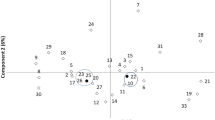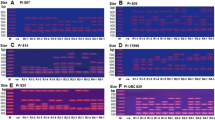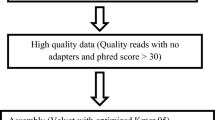Abstract
Main conclusion
As a result of this work, we were able to characterize seven indigenous to Greece Salvia officinalis populations using genetic and metabolomic tools. These tools can be used to select the most promising genotypes, capable to design future breeding programs for high valuable varieties.
An initial investigation was carried out to compare the genetic and metabolic diversity in S. officinalis grown in Greece and to discern the relationship between the two sets of data. Analysis of inter-simple sequence repeats (ISSR) revealed significant genetic differences among seven sage populations, which were grouped into three main clusters according to an UPGMA ISSR data-based dendrogram and Principle Coordinate Analysis. 80 loci were scored of which up to 90% were polymorphic at species level. According to the composition of their essential oil, the populations were classified into two chemotypes: 1.8 cineole/α-thujone and α-thujone/1.8 cineole. Additionally, a targeted ultra performance liquid chromatography (UPLC–MS/MS) method was used to qualify and quantify phenolic compounds in methanolic extracts of the seven sage genotypes according to which they were districted in six clusters among the sage populations. The main compounds characterizing the seven genotypes were rosmarinic acid and carnosol, followed by apigenin-7-O-glucoside (Ap7glc), and luteolin-7-O-glucoside (Lu7glc). The correlation between matrices obtained from ISSR data and metabolic profiles was non-significant. However, based on the differences in metabolic fingerprint, we aimed to define populations using as main selection criteria the high polyphenol content and desired essential oil composition, using state to the art analytical tools for the identification of parent lines for breeding programs.








Similar content being viewed by others
Abbreviations
- ISSR:
-
Inter-simple sequence repeats
- PCoA:
-
Principal coordinate analysis
- SOP:
-
Salvia officinalis population
References
Abreu M, Muller M, Alegre L, Munne-Bosch S (2008) Phenolc diterpene and α-tocopherol contents in leaf extracts of 60 Salvia species. J Sci Food Agric 88:2648–2653
Adams RP (1995) Identification of volatile oil components by gas chromatography/mass spectroscopy. Allured publishing Co., CarolStream, IL, USA
Alizade A, Shaabani M (2012) Essential oil composition, phenolic content, antioxidant and antimicrobial activity in (Salvia officinalis L.) cultivated in Iran. Adv Environ Biol 6:221–226
Baricevic D, Bartol T (2000) The biological/pharmacological activity of the Salvia genus. In: Kintzios SE (ed) Sage, the genus Salvia. OPA, Harwood Academic Publishers, The Netherlands, pp 141–178
Baydar H, Sangun Kemal M, Erbas S, Kara N (2013) Comparison of aroma compounds in distilled and extracted products of sage (Salvia officinalis L.). J Essent Oil Bear Plants 16:39–44
Bazina E, Makris A, Vender C, Skoula M (2002) Genetic and chemical relations among selected clones of Salvia officinalis. J Herbs Spices Med Plants 9:269–273
Bettaieb I, Zakhama N, Wannes WA, Kchouk ME, Marzouk B (2009) Water deficit effects on Salvia officinalis fatty acids and essential oils composition. Sci Hortic 120:271–275
Boszormenyi A, Hethelyi E, Farkas A, Horvath G, Papp N, Lemberkovics E, Szoke E (2009) Chemical and genetic relationships among sage (Salvia officinalis L.) cultivars and Judean sage (Salvia judaica Boiss.). J Agric Food Chem 57:4663–4667
Bouaziz M, Yangui T, Sayadi S, Dhouib A (2009) Disinfectant properties of essential oils from Salvia officinalis L. cultivated in Tunisia. Food Chem Toxicol 47:2755–2760
Cheynier V, Comte G, Davies KM, Lattanzio V, Martens S (2013) Plant phenolics: recent advances on their biosynthesis, genetics, and ecophysiology. Plant Physiol Biochem 72:1–20
Cvetkovikj I, Stefkov G, Acevska J, Stanoeva JP, Karapandzova M, Stefova M, Dimitrovska A, Kulevanova S (2013) Polyphenolic characterization and chromatographic methods for fast assessment of culinary Salvia species from South East Europe. J Chromatogr A 1282:38–45
Dent M, Dragovic-Uzelac V, Penic M, Brncic M, Bosiljkov T, Levaj B (2013) The effect of extraction solvents, temperature and time on the composition and mass fraction of polyphenols in Dalmatian wild sage (Salvia officinalis L.) extracts. Food Technol Biotechnol 51:84–91
Dudai N, Lewinsohn E, Larkov O, Katzir I, Ravid U, Chaimovitsh D, Saad D, Putievsky E (1999) Dynamics of yield components and essential oil production in a commercial hybrid sage (Salvia officinalis × Salvia fruticosa cv. Newe Ya’ar No. 4). J Agric Food Chem 47:4341–4345
El-Feky AM, Aboulthana WM (2016) Phytochemical and biochemical studies of sage (Salvia officinalis L.). UK J Pharm Biosci 45:56–62
EMA/HMPC/330383/2008 (2009) Assessment report on Salvia officinalis L., Folium and Salvia officinalis L., aetheroleum. European Medicines Agency, Committee on Herbal Medicinal Products (HMPC), London
Evanno G, Regnaut S, Goudet J (2005) Detecting the number of clusters of individuals using the software STRUCTURE: a simulation study. Mol Ecol 14:2611–2620
Farkas A, Papp N, Horvath G, Nemeth TS, Szabo I, Nemeth T (2008) RAPD based genetic diversity among Salvia officinalis L. populations. Farmacia 56:339–343
Fridman E, Pleban T, Zamir D (2000) A recombination hotspot delimits a wild-species quantitative trait locus for tomato sugar content to 484 bp within an invertase gene. Proc Natl Acad Sci USA 9:4718–4723
Gibon Y, Rolin D, Deborde C, Bernillon S, Moing A (2012) New opportunities in metabolomics and biochemical phenotyping for plant systems biology. In: Roessner U (ed) Biochemistry, genetics and molecular biology. Metabolomics, pp 953–978. InTech. doi:10.5772/31639
Graham IA, Besser K, Blumer S, Branigan CA, Czechowski T, Elias L, Guterman I, Harvey D, Isaac PG, Khan AM, Larson TR, Li Y, Pawson T, Penfield T, Rae AM, Rathbone DA, Reid S, Ross J, Smallwood MF, Segura V, Townsend T, Vyas D, Winzer T, Bowles D (2010) The genetic map of Artemisia annua L. identifies loci affecting yield of the antimalarial drug artemisinin. Science 327:328–331
Grdisa M, Jug-Dujakovic M, Loncaric M, Carovic-Stanko K, Nincevi T, Lber Z, Radosavljevic I, Satovic Z (2015) Dalmatian sage (Salvia officinalis L.,): a review of biochemical contents, medical properties and genetic diversity. Agric Conspec Sci 80:69–78
Hendawy SF, Khalid KA (2005) Response of sage (Salvia officinalis L.) plants to zinc application under different salinity levels. J Appl Sci Res 1:147–155
Hossain MB, Brunton NP, Martin-Diana AB, Barry-Ryan C (2010) Application of response surface methodology to optimize pressurized liquid extraction of antioxidant compounds from sage (Salvia officinalis L.), basil (Ocimum basilicum L.) and thyme (Thymus vulgaris L.). Food Funct 1:269–277
Jug-Dujaković M, Ristić M, Pljevljakušić D, Dajić-Stevanović Z, Liber Z, Hančević K, Radić T, Šatović Z (2012) High diversity of indigenous populations of dalmatian sage (Salvia officinalis L.) in essential oil composition. Chem Biodivers 9:2309–2323
Karaca M, Ince AG, Ay ST, Turgut K, Onus AN (2008) PCR-RFLP and DAMD-PCR genotyping for Salvia species. J Sci Food Agric 88:2508–2516
Karousou R, Hanlidou E, Kokkini S (2000) The Sage plants of Greece: Distribution and infraspecific variation. In: Kintzios SE (ed) Sage, the genus Salvia. OPA, Harwood Academic Publishers, The Netherlands, pp 141–178
Lamien-Meda A, Schmiderer C, Lohwasser U, Borner A, Franz C, Novak J (2010) Variability of the essential oil composition in the sage collection of the Genebank Gatersleben: a new viridiflorol chemotype. Flavour Fragr J 25:75–82
Laurentin H, Ratzinger A, Karlovsky P (2008) Relationship between metabolic and genomic diversity in sesame (Sesamum indicum L.). BMC Genom 9:250. doi:10.1186/1471-2164-9-250
Leelambika M, Mahesh S, Jaheer M, Tripathi PK, Kumar PR, Sathyanarayana N (2016) Targeted metabolic and genomic profiling reveals parents for L-Dopa breeding in Mucuna pruriens (L.) DC. Trop Plant Biol 9:239–251
Luis JC, Johnson CB (2005) Seasonal variations of rosmarinic and carnosic acids in rosemary extracts. Analysis of their in vitro antiradical activity. Span J Agric Res 3:106–112
Mader E, Lohwasser U, Borner A, Novak J (2010) Population structures of genebank accessions of Salvia officinalis L. (Lamiaceae) revealed by high resolution melting analysis. Biochem Syst Ecol 38:178–186
Maksimović M, Vidic D, Miloš M, Šolić ME, Abadžić S, Siljak-Yakovlev S (2007) Effect of the environmental conditions on essential oil profile in two Dinaric Salvia species: S. brachyodon Vandas and S. officinalis L. Biochem Syst Ecol 35:473–478
Martins N, Barros L, Santos-Buelga C, Henriques M, Silva S, Ferreira IC (2015) Evaluation of bioactive properties and phenolic compounds in different extracts prepared from Salvia officinalis L. Food Chem 170:378–385
Masuda T, Inaba Y, Maekawa T, Takeda Y, Tamura H, Yamaguchi H (2002) Recovery mechanism of the antioxidant activity from carnosic acid quinone, an oxidized sage and rosemary antioxidant. J Agric Food Chem 50:5863–5869
Munné-Bosch S, Alegre L, Schwarz K (2000) The formation of phenolic diterpenes in Rosmarinus officinalis L. under Mediterranean climate. Eur Food Res Technol 210:263–267
Nei M (1978) Estimation of average heterozygosity and genetic distance from a small number of individuals. Genetics 89:583–590
Nell M, Voetsch M, Vierheilig H, Steinkellner S, Zitterl-Eglseer K, Franz C, Novak J (2009) Effect of phosphorus uptake on growth and secondary metabolites of garden sage (Salvia officinalis L.). J Sci Food Agric 89:1090–1096
Papageorgiou V, Gardeli C, Mallouchos A, Papaioannou M, Komaitis M (2008) Variation of the chemical profile and antioxidant behavior of Rosmarinus officinalis L. and Salvia fruticosa Miller grown in Greece. J Agric Food Chem 56:7254–7264
Peakall R, Smouse PE (2006) GENALEX 6: genetic analysis in Excel. Population genetic software for teaching and research. Mol Ecol Notes 6:288–295
Peakall R, Smouse PE (2012) GenAlEx Tutorials-Part 2: genetic distance and analysis of molecular variance (AMOVA). http://www.anu.edu.au/BoZo/GenAlEx/
Peng L, Ru M, Wang B, Wang Y, Li B, Yu J, Liang Z (2014) Genetic diversity assessment of a germplasm collection of Salvia miltiorrhiza Bunge based on morphology, ISSR and SRAP markers. Biochem Syst Ecol 55:84–92
Powell W, Machray GC, Provan J (1996) Polymorphism revealed by simple sequence repeats. Trends Plant Sci 1:215–222
Pritchard JK, Stephens M, Donnelly P (2000) Inference of population structure using multilocus genotype data. Genetics 155:945–959
Raal A, Orav A, Arak E (2007) Composition and essential oil of Salvia officinalis L., from various European countries. Nat Prod Res 21:406–411
Rešetnik I, Baričevič D, Batîr Rusu D, Carović-Stanko K, Chatzopoulou P, Dajić-Stevanović Z, Gonceariuc M, Grdiša M, Greguraš D, Ibraliu A, Jug-Dujaković M, Krasniqi E, Liber Z, Murtić S, Pećanac D, Radosavljević I, Stefkov G, Stešević D, Šoštarić I, Varbanova K, Šatović Z (2016) Genetic diversity and demographic history of wild and cultivated/naturalised plant populations: evidence from Dalmatian sage (Salvia officinalis L., Lamiaceae). PLoS One 11:1–23
Riedelsheimer C, Lisec J, Czedik-Eysenberg A, Sulpice R, Flis A, Grieder C, Altmann T, Stitt M, Willmitzer L, Melchinger AE (2012) Genome-wide association mapping of leaf metabolic profiles for dissecting complex traits in maize. Proc Natl Acad Sci USA 109:8872–8877
Riedelsheimer C, Brotman Y, Meret M, Melchinger AE, Willmitzer L (2013) The maize leaf lipidome shows multilevel genetic control and high predictive value for agronomic traits. Sci Rep 3:2479. doi:10.1038/srep02479
Roby MHH, Sarhan MA, Selim KAH, Khalel KI (2013) Evaluation of antioxidant activity, total phenols and phenolic compounds in thyme (Thymus vulgaris L.), sage (Salvia officinalis L.), and marjoram (Origanum majorana L.) extracts. Ind Crops Prod 43:827–831
Santos-Gomes PC, Fernandes-Ferreira M (2001) Organ and season-dependent variation in the essential oil composition of Salvia officinalis L. cultivated at two different sites. J Agric Food Chem 49:2908–2916
Sarrou E, Martens S, Chatzopoulou P (2016) Metabolite profiling and antioxidant activity of sage (Salvia fruticosa Mill.) under the influence of genotype and harvesting period. Ind Crops Prod 94:240–250
Seidler-Łożykowska K, Mordalski R, Król D, Bocianowski J, Karpińska E (2015) Yield and quality of sage herb (Salvia officinalis L.) from organic cultivation. Biol Agric Hortic 31:53–60
Seymour FA, Cresswell JE, Fisher PJ, Lappin-Scott HM, Haag H, Talbot NJ (2004) The influence of genotypic variation on metabolite diversity in populations of two endophytic fungal species. Fungal Genet Biol 41:721–734
Skoula M, El Hilali I, Makris AM (1999) Evaluation of the genetic diversity of Salvia fruticosa Mill. clones using RAPD markers and comparison with the essential oil profiles. Biochem Syst Ecol 27:559–568
Sneath PH, Sokal RR (1973) Numerical taxonomy. The principles and practices of numerical classification. WF Freeman and Co., San Francisco, p 573
Song Z, Li X, Wang H, Wang J (2010) Genetic diversity and population structure of Salvia miltiorrhiza Bge in China revealed by ISSR and SRAP. Genetica 138:241–249
Taarit MB, Msaada K, Hosni K, Marzouk B (2010) Changes in fatty acid and essential oil composition of sage (Salvia officinalis L.) leaves under NaCl stress. Food Chem 119:951–956
Tounekti T, Munné-Bosch S (2012) Enhanced phenolic diterpenes antioxidant levels through non-transgenic approaches. Crit Rev Plant Sci 31:505–519
Vrhovsek U, Masuero D, Gasperotti M, Franceschi P, Caputi L, Viola R, Mattivi F (2012) A versatile targeted metabolomics method for the rapid quantification of multiple classes of phenolics in fruits and beverages. J Agric Food Chem 60:8831–8840
Walch S, Kuballa T, Stuhlinger W, Lachenmeier D (2011a) Determination of biologically active flavor substances thujone and camphor in foods and medicines containing sage (Salvia officinalis L.). Chem Central J 5:2–10
Walch SG, Ngaba Tinzoh L, Zimmermann BF, Stühlinger W, Lachenmeier DW (2011b) Antioxidant capacity and polyphenolic composition as quality indicators for aqueous infusions of Salvia officinalis L. (sage tea). Front Pharmacol 2:79. doi:10.3389/fphar.2011.00079
Wellwood CR, Cole RA (2004) Relevance of carnosic acid concentrations to the selection of rosemary, Rosmarinus officinalis (L.), accessions for optimization of antioxidant yield. J Agric Food Chem 52:6101–6107
Wise ML, Savage TJ, Katahira E, Croteau R (1998) Monoterpene synthases from common sage (Salvia officinalis) cDNA isolation, characterization, and functional expression of (+)-sabinene synthase, 1,8-cineole synthase, and (+)-bornyl diphosphate synthase. J Biol Chem 273:14891–14899
Wolde-Meskel E, Terefework Z, Lindström K, Frostegård Å (2004) Metabolic and genomic diversity of rhizobia isolated from field standing native and exotic woody legumes in southern Ethiopia. Syst Appl Microbiol 27:603–611
Wolfender JL, Rudaz S, Choi YH, Kim HK (2013) Plant metabolomics: from holistic data to relevant biomarkers. Curr Med Chem 20:1056–1090
Yeh FC, Yang RC, Boyle T (1999) POPGENE: Microsoft Windows-based freeware for population genetic analysis. University of Alberta, Edmonton
Yousefiazarkhanian M, Asghari A, Ahmadi J, Asghari B, Jafari AA (2015) Genetic diversity assessment of some Salvia sp. ecotypes based on ISSR markers. Biol Forum 7:286–288
Zawiślak G, Dyduch J (2006) The analysis of the content and chemical composition of essential oil in the leaves of sage (Salvia officinalis L.) cv. ‘Bona’ in the second year of cultivation. J Essent Oil Res 18:402–404
Zimmermann BF, Walch SG, Tinzoh LN, Stühlinger W, Lachenmeier DW (2011) Rapid UHPLC determination of polyphenols in aqueous infusions of Salvia officinalis L. (sage tea). J Chromatogr B 879:2459–2464
Acknowledgements
This research was supported partially from Cost Action FP1203 “European Non-Wood Forest Products Network” during a short-term scientific mission of Eirini Sarrou, by Hellenic Agricultural Organization ‘DEMETER’ and by ADP 2011–2016 project funded by the Autonomous Province of Trento.
Author information
Authors and Affiliations
Corresponding author
Additional information
Special topic: Polyphenols II: biosynthesis and function in plants and ecosystems. Guest editor: Stefan Martens.
Electronic supplementary material
Below is the link to the electronic supplementary material.
Rights and permissions
About this article
Cite this article
Sarrou, E., Ganopoulos, I., Xanthopoulou, A. et al. Genetic diversity and metabolic profile of Salvia officinalis populations: implications for advanced breeding strategies. Planta 246, 201–215 (2017). https://doi.org/10.1007/s00425-017-2666-z
Received:
Accepted:
Published:
Issue Date:
DOI: https://doi.org/10.1007/s00425-017-2666-z




